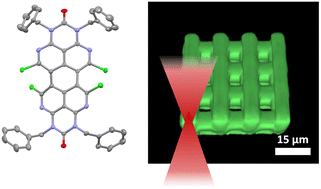Two-photon microprinting of 3D emissive structures using tetraazaperylene-derived fluorophores†
Abstract
The application of a new class of fluorophores based on a twisted tetraazaperylene core in the fabrication of emissive organic 3D microstructures has been investigated. The synthesis of a series of tetraazaperyleneamines and their corresponding octaazaperopyrenedioxides (OAPPDOs) with different N-benzyl substituents is reported and their formulation in a photoresist for two-photon laser printing is tested. While the direct incorporation of synthesized tetraazaperylene derivatives in a commercially available resist proved to be insufficient due to insolubility, a homogeneous formulation of the fluorophores using pentaerythritol triacrylate (PETA) as a crosslinker and phenyl-bis-(2,4,6-trimethylbenzoyl)-phosphine oxide (BAPO) as a photoinitator could be achieved. In particular, no significant inhibition of the photopolymerization and therefore, of the printing process has been detected in the presence of the fluorophore OAPPDO derivates in the optimized formulations. Various complex 3D microstructures were successfully printed and characterized using confocal fluorescence microscopy. Importantly, it is shown that tetraazaperylene fluorophores functionalized with 3,4,5-trimethoxybenzyl N-substituents were successfully embedded and distributed homogeneously in the 3D microstructures.

- This article is part of the themed collection: MSDE Recent HOT Articles


 Please wait while we load your content...
Please wait while we load your content...